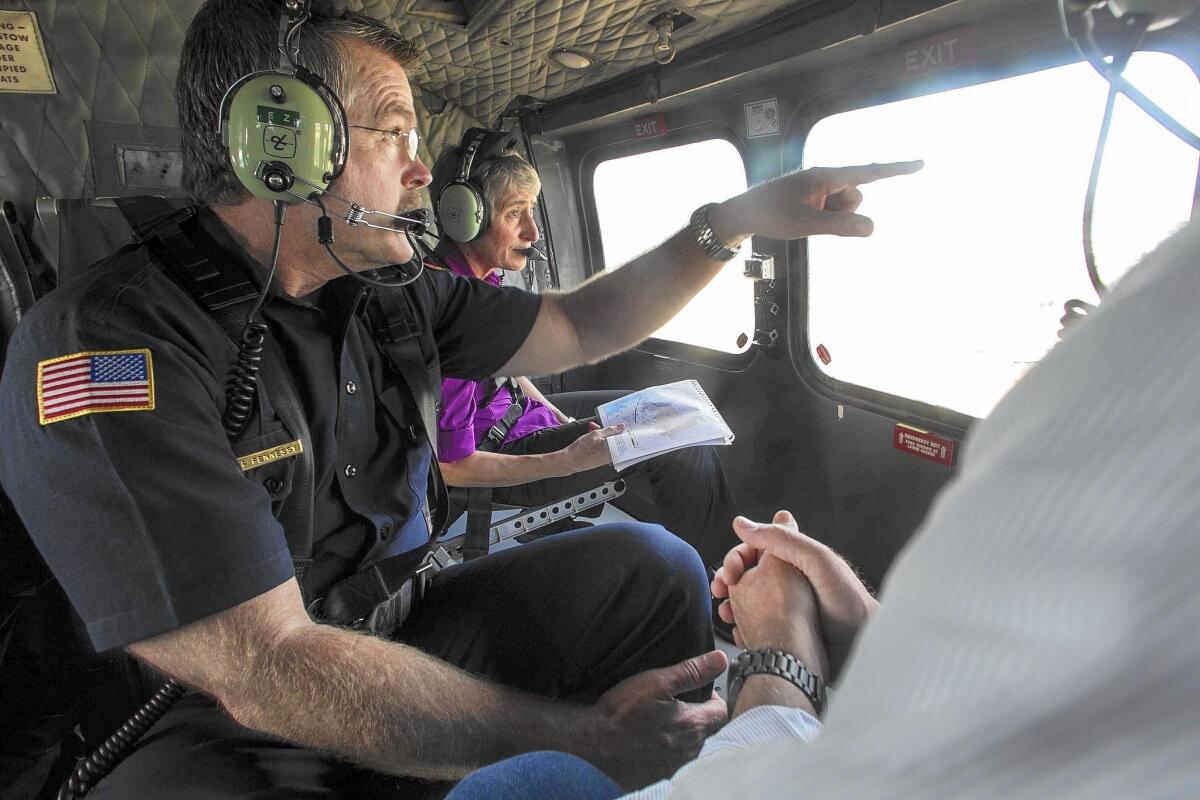Changing how government manages wildfires could save more homes, officials say

- Share via
Reporting from El Cajon, Calif. — When it comes to wildfires, some federal officials are tired of playing catch-up and leaving private property at heightened risk of a blaze.
“We’re really in a negative spiral right now,” Secretary of the Interior Sally Jewell said before she boarded a helicopter last week to tour of parts of San Diego County burned by the massive Cedar fire in 2003.
The problem isn’t the result of equipment, training or firefighting strategies, Jewell said. Instead, the problem is rooted in how the government pays to both prevent and fight wildfires, she said.
Jewell said that a change to the complex federal budget could cut the risk of homes going up in flames when a backcountry fire spreads.
When there are major wildfires, the department has to shift some of the money it planned to spend building firebreaks, teaching homeowners how to safeguard their property and other preventive measures to fighting fires.
This accounting maneuver helps the feds and their local partners in emergency situations. But it saps the prevention and rehabilitation budget to prepare for the next big wildfire, she said, adding there’s a greater risk of more and bigger blazes in the future.
“We do not have the capacity in the federal budget to treat those as the emergencies that they really are, as the disasters they really are,” she said as the region heads into the height of the wildfire season.
“When you have a tornado, and you have a flood, and you have a hurricane, or an earthquake, those are natural disasters, and we go to the disaster fund to take care of that so year in year out, landscapes can be protected from those events. We do not have that capacity with fire. It means we are not doing the work to reduce the risk of fighting fires long term.”
But if officials find a solution, homes and other properties will be safer, Jewell said.
Rep. Scott Peters (D-San Diego), who joined Jewell on the tour, and others are trying to change the way the federal government manages wildfires. Instead of transferring wildfire prevention funds to firefighting, they want a wildfire suppression budget to be based on the 10-year average total spent on wildfires. This will stop federal departments from dipping into their prevention funds to put out today’s wildfires, they say.
“How stupid is it?” he said of the current process.
Peters said he’s trying to bring the issue to the House floor and force a vote where he believes it will receive bipartisan support from about 300 members. The detractors, he said, are bound by “the tyranny of this year’s budget” and are worried that it will increase spending. Peters said it might increase spending in the short term, but fewer and smaller wildfires in the future will make up for the savings.
“We would fix the root this year and save the money down the line,” he said.
Jewell said the overall cost of wildfire management programs could increase in years in which there are several big fires, but otherwise the expenses will be equal or below current levels.
In September, Jewell, Office of Management and Budget Director Shaun Donovan and Agriculture Secretary Tom Vilsack wrote a letter to Congress urging members to overhaul the way Washington funds its wildfire programs. (The Forest Service is under the Department of Agriculture.)
They wrote that they’re consistently spending a greater portion of their budgets on fighting wildfires at the cost of prevention, recreation, research and other efforts.
Half of the Forest Service’s budget is spent on firefighting and related efforts, up from one-sixth in 1995. By 2025 they predict that two-thirds of the budget will be spent on fighting wildfires, they wrote.
Also, the Forest Service has shifted money in seven of the last 14 years, while the Department of the Interior had to shift funds six times. In all, they’ve shifted $700 million this year, records show.
Global warming has heightened the need to change how the government pays to fight wildfires, Jewell said, adding that the fire season is 78 days longer now than in 1970 and is expected to get even longer.
joshua.stewart@sduniontribune.com
Joshua Stewart writes for the San Diego Union-Tribune.
More to Read
Sign up for Essential California
The most important California stories and recommendations in your inbox every morning.
You may occasionally receive promotional content from the Los Angeles Times.













